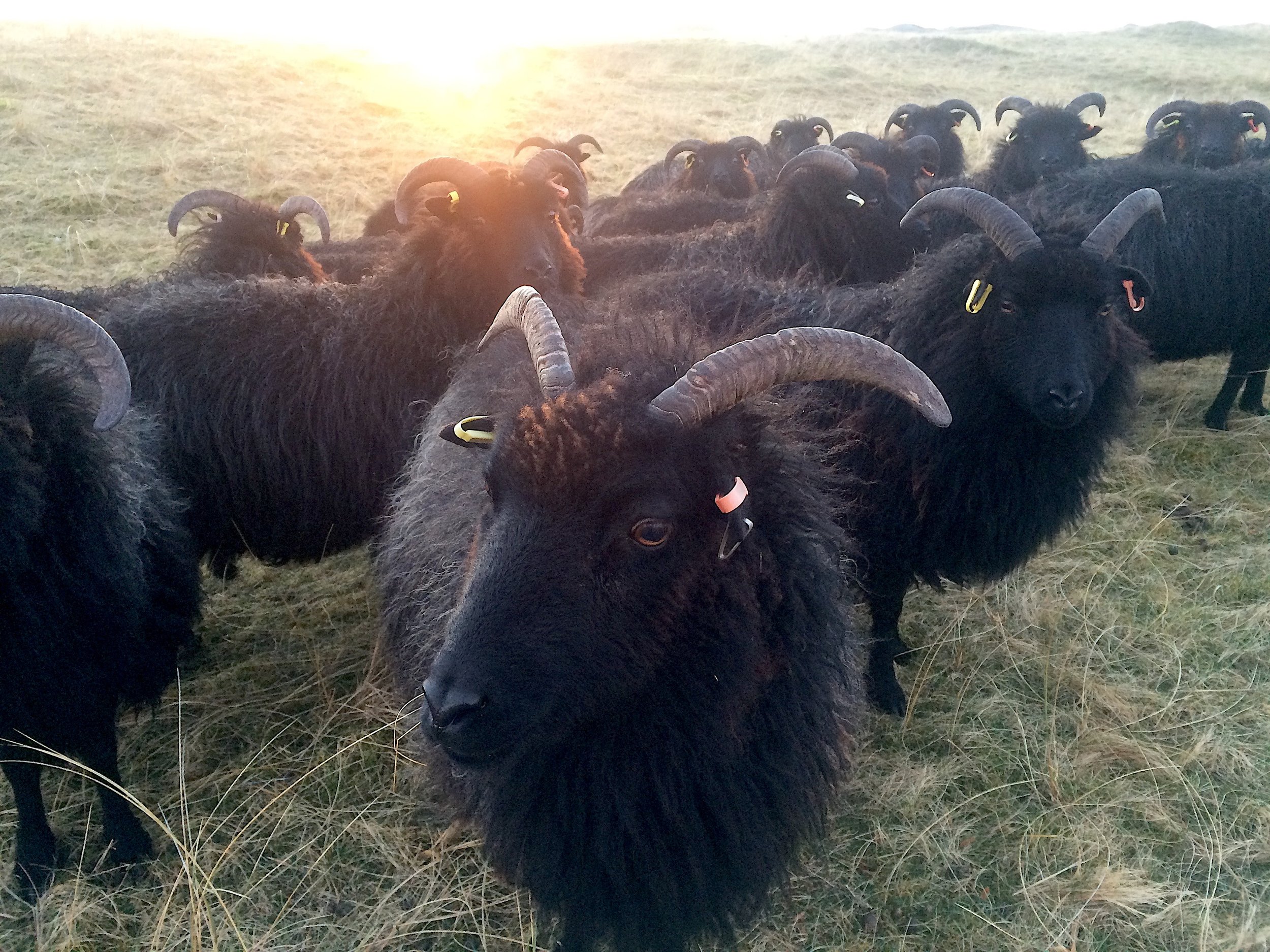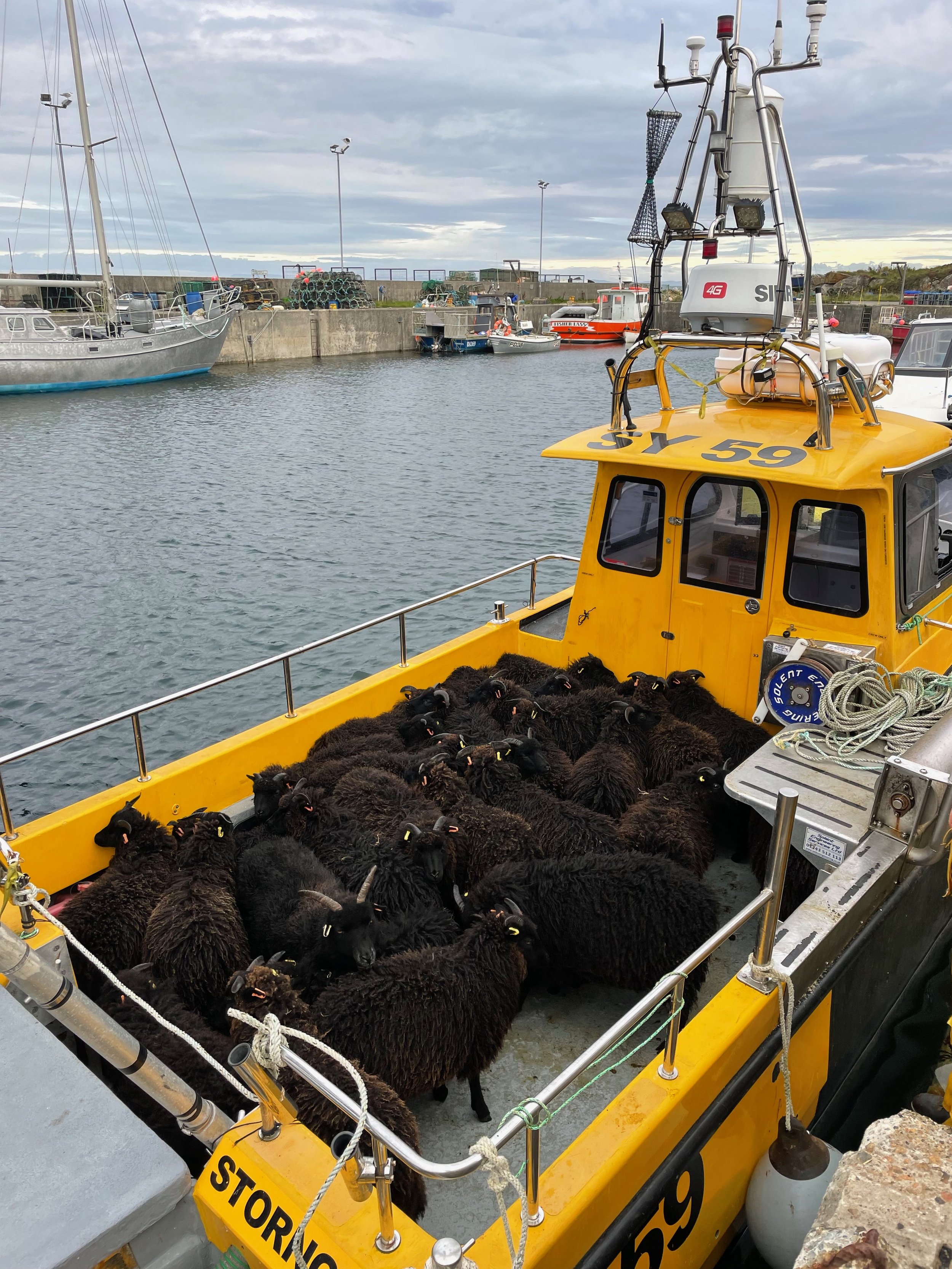Where do you live in the world, and what do you love about it?
I live on Berneray, a tiny Hebridean island on the edge of the Atlantic two hours by ferry from mainland Scotland. It is a stunning, harsh and awe inspiring. Here nature puts you in your place, it humbles you with its force and inspires you with its beauty—whether that be sailing in the company of playful dolphins, the roar of rutting red deer across the moorlands or tiny colourful shells on our beaches. While it can at times be tough going, I couldn’t and wouldn’t wish to live anywhere else.
The Sunhill flock
Tell me a bit about your sheep…
With my family, I run a croft (small holding) on Cnoc na Grèine (which translates from Gaelic as Hill of the Sun). Here we rear pedigree Hebridean sheep that were originally brought to the Hebrides by the Vikings around the mid 9th Century. They are part of the wider North Atlantic Short-tailed sheep breed found across the North Atlantic, dispersed by the Norse people who took their hardy little sheep with them as they migrated. Hence, why you can find them every where the Norwegian Vikings settled as far south as the Isle of Man and as far north-west as Greenland.
During the clearances in the mid 19th Century, when many landlords in the Highlands and Islands cleared their lands of their smallholder tenants, these little black sheep were turfed off to make way for more commercial sheep breeds. Since then, breeds such as Cheviot and Texel have dominated the sheep scene in the region. As a result, the Hebridean sheep breed declined in numbers such that they were placed on the rare breed lists. However, thankfully many crofters in the islands and small holders on the mainland are now breeding Hebridean sheep once more and while still rare, the breed is no longer under threat.
Meg with a Hebridean lamb
Birlinn carving, Clan MacLeod Chapel, St Clement’s Church, Rodel, South Harris
Where does the name Birlinn come from, and what is the connection to your yarn?
The ancestors of our Hebridean sheep would have originally have been brought to our shores in Viking long boats or knarr and a birlinn is a Hebridean version of a knarr. The Viking long boats were built for extensive sea-passages as they were long and sailed fast in a straight line. However, this boat design needed to be adapted for interisland travel. It was shortened in order that it could turn more easily, avoiding rocks and navigating between islands. The logo for The Birlinn Yarn Company was developed from a drawing I made of a stone carving in the Clan MacLeod’s Chapel in Rodel, South Harris. The carving dates back to the 15th Century so it is interesting to see that the boat design persisted long after the Norse people had left in the mid 13th Century.
Every summer we take our sheep by boat to off-shore islands for weaning and summer grazing. This has been done for hundreds of years but it is only ourselves and one other island family that still maintain this practice. Given that our sheep originally came by boat with the Vikings and that they are still voyaging the Sound of Harris every summer, I like to refer to them as my ‘seafaring’ sheep and it seemed appropriate to take on board the Birlinn logo and name, hence—The Birlinn Yarn Company.
Seafaring sheep!
A Hebridean palette
Tell us a bit more about your special yarn?
Since starting out in 2017, The Birlinn Yarn Company has steadily grown such that I now work with quite a number of local island crofters buying in both Hebridean and Cheviot fleeces. I am careful only to work with crofters with good animal husbandry and crofting practice to ensure the sustainability of the fleece that I buy, with all my wool traceable to individual crofts. At the mill, we blend the black with white wool in order to get a range of natural coloured yarns. We then take a proportion of the grey blends and over-dye them following a GOTS registered organic dye process to achieve our Hebridean colour range. Every step is carefully assessed to ensure as light a touch as possible on the environment.
This crofting lifestyle is not for everyone. There are tough, dark days of oilskins, mud and wellies - not much glamour in that! However, there are also days of glorious calm on the west side beach of Berneray without a soul. Where I give thanks for my place in the world. At the heart of what I do is my commitment to take care of this treasured island for the short time I am here. To tread lightly, respectfully and with great care.
The floral carpet, white shell sand, and azure water of Berneray’s west side beach.
The Tiny Boats collection
What does the Tiny Boats project mean to you?
The Tiny Boats project has been so beautifully and intuitively designed by Elizabeth. It is clear that the Hebrides, for some magical reason, has a real draw on her and she has captured those little rocking boats with delicate details and a twist of humour. As a family, seafaring is what we do. My husband is a marine scientist and lobster fisherman, we sail and also ferry our sheep back and forth from those off shore islands sharing the skippering as needs be - we know these waters, we know the sea and treat it with great respect. That’s why Elizabeth’s Tiny Boats project is such a great fit for Birlinn Yarn.
Thanks, Meg!
If this has inspired you to knit your own woolly fleet, here’s where you can find the Tiny Boats patterns…and be sure to check out Meg’s beautiful yarns and kits for Tiny Boats on the the Birlinn Yarn Company’s website.








